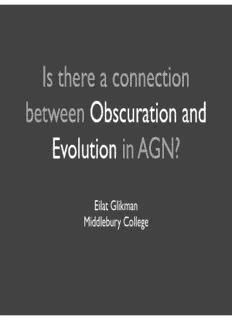
Is there a connection between Obscuration and Evolution in AGN? PDF
Preview Is there a connection between Obscuration and Evolution in AGN?
Is there a connection between Obscuration and Evolution in AGN? Eilat Glikman Middlebury College “How much evidence is there that obscured AGN reside in different environments (i.e. dark matter halos, host galaxies, evolutionary phases) compared to unobscured AGN?” A B C D “How much evidence is there that obscured AGN reside in different environments (i.e. dark matter halos, host galaxies, evolutionary phases) compared to unobscured AGN?” Strong • Covering factor of the obscuring medium is not a universal constant ... obscured objects will be more common in the intrinsically high CF objects, and the opposite for the unobscured AGN. • CT AGNs reside in advanced mergers based on recent work in the X-ray, NuSTAR, and mid-IR WISE. • Mainly driven by luminosity. “How much evidence is there that obscured AGN reside in different environments (i.e. dark matter halos, host galaxies, evolutionary phases) compared to unobscured AGN?” Moderate • It potentially depends on the luminosity of the AGN. • At high redshift ... some percentage of obscured and heavily reddened AGN are a distinct evolutionary phase. ...less certain at lower redshifts. • Mid-IR, X-ray and radio selected AGN show different clustering properties. • Might depend on what you mean by "obscured." “How much evidence is there that obscured AGN reside in different environments (i.e. dark matter halos, host galaxies, evolutionary phases) compared to unobscured AGN?” Weak • Selection effects. • It is difficult to select type 1 and type 2 AGN with the same intrinsic luminosity in order to make a proper comparison. • Obscured AGNs reside in different environments [at] high-z, but ... should be investigated further [in] local universe. • Weak evidence from observations, ... use large cosmological simulations ... to compare the clustering properties of simulated AGN with observations. “How much evidence is there that obscured AGN reside in different environments (i.e. dark matter halos, host galaxies, evolutionary phases) compared to unobscured AGN?” None • The clustering results are weak. Different selection techniques recover different AGN Mendez et al. 2013 Hickox et al. 2009 Orientation, evolution, environment, something else? An evolutionary model “Ultraluminous Infrared galaxies represent the initial, dust-enshrouded stages of quasars. Once these nuclei shed their obscuring dust, allowing AGN to visually dominate the decaying starburst, they become optically selected quasars.” Sanders et al. 1988 An evolutionary model Hopkins et al. 2006 An evolutionary model Hopkins et al. 2006
Description: